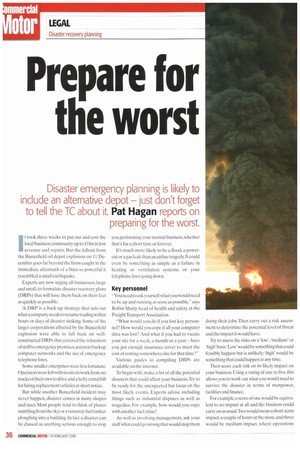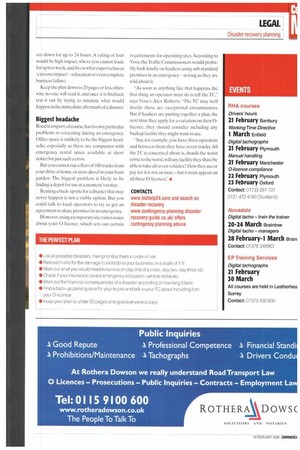Prepare for the worst
Page 36

Page 37

If you've noticed an error in this article please click here to report it so we can fix it.
Disaster emergency planning is likely to
include an alternative depot — just don't forget to tell the IC about it. Pat Hagan reports on
preparing for the worst.
It took three weeks to put out and cost the local business community up to ilbn in lost revenue and repairs. But the fallout from the Buncefield oil depot explosion on 11 December goes far beyond the firms caught in the immediate aftermath of a blast so powerful it resembled a small earthquake.
Experts are now urging all businesses, large and small, to formulate disaster recovery plans (DRPs) that will have them hack on their feet as quickly as possible.
A DRP is a back-up strategy that sets out what a company needs to resume trading within hours or days of disaster striking. Some of the larger corporations affected by the Buncefield explosion were able to fall back on wellconstructed DRPs that covered the relocation of staff to emergency premises. access to backup computer networks and the use of emergency telephone lines.
Some smaller enterprises were less fortunate. Operators were left with no site to work from.no trucks of their own to drive and a hefty rental bill for hiring replacement vehicles at short notice.
But while another Buncefield incident may never happen, disaster comes in many shapes and sizes. Most people tend to think of planes tumbling from the skyor a runaway fuel tanker ploughing into a building. In fact a disaster can he classed as anything serious enough to stop you performing your normal business, whether that's for a short time or forever.
It's much more likely to be a flood, a powercut or a gas leak than an airline tragedy. It could even he something as simple as a failure in heating or ventilation systems, or your telephone lines going down.
Key personnel -youft2,2LI to ask yourself what you would need to be up iind running as soon as possible." says Robin Sharp, head of health and safety at the Freight Transport Association.
"What would you do if you lost key personnel? How would you cope if all your computer data was lost? And what if you had to vacate your site for a week, a month or a year — have you got enough insurance cover to meet the cost of renting somewhere else for that time?"
Various guides to compiling DRPs are available on the internet.
To begin with, make a list of all the potential disasters that could affect your business. Tr to he ready for the unexpected hut focus on the most likely events. Experts advise including things such as industrial disputes as well as tragedies. For example, how would you cope with another fuel crisis?
As well as involving management, ask your staff what could go wrong that would stop them doing their jobs. Then carry out a risk assessment to determine the potential level of threat and the impact it would have.
Try to assess the risks on a low', 'medium or 'high' basis,'Low' would be something that could feasibly happen but is unlikely; 'high' would be something that could happen at any time.
Then score each risk on its likely impact on your business. Using a rating of one to five, this allows you to work out what you would need to survive the disaster in terms of manpower, facilities and finance.
For example, a score of one would be equivalent to no impact at all and the business could carry on as usual.Two would mean a short-term impacta couple of hours at the most, and three would be medium impact, where operations
are down for up to 24 hours. A rating of four would be high impact. where you cannot trade for up to a week.and live is what experts class as 'extreme impact' relocation or even complete business failure.
Keep the plan down to 20 pages or less, otherwise no-one will read it, and once it is finalised, test it out by trying to simulate what would happen in the immediate aftermath of a disaster.
Biggest headache
Road transport.of course, has i ts own particular problems in relocating during an emergency. Office space is unlikely to be the biggest headache. especially as there are companies with emergency rental space available at short notice for just such a crisis But you cannot run a fleet of 100 trucks from your drive at home.or store diesel in your front garden. The biggest problem is likely to be finding a depot for use at a moment's notice.
Renting a back-up site for a disaster that may never happen is not a viable option. But you could talk to local operators to try to get an agreement to share premises in an emergency.
However. using a temporary site raises issues about your 0-licence, which sets out certain requirements for operating sites. According to Vosa. the Traffic Commissioners would probably look kindly on hauliers using sub-standard premises in an emergency as long as they are told about it.
"As soon as anything like that happens. tht: first thing an operator must do is tell the TC.says Vosa's Alex Roberts. -The TC may well decide these are exceptional circumstances. But if hauliers are putting together a plan, thc next time they apply for a variation on their 0licence, they should consider including an backup facility they might want to use.
"Say, for example, you have three operators and between them they have seven trucks. All the TC is concerned about is, should the worst come to the worst.will any facility they shart' able to take all seven vehicles? How they use or pay for it is not an issue but it must appear on all three 0-licences.' •
CONTACTS www.bizhelp24.com and search on disaster recovery www.contingency-planning-disasterrecovery-guide.co.uk/ offers contingency planning advice






































































































































































































